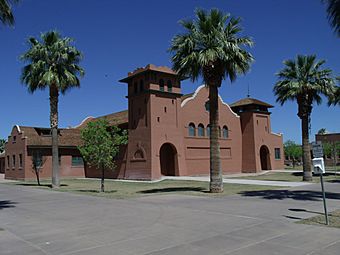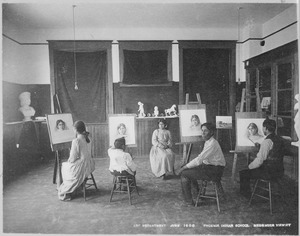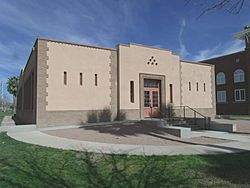Phoenix Indian School facts for kids
Quick facts for kids |
|
|
Phoenix Indian School Historic District
|
|

Phoenix Indian School
|
|
| Location | 300 E. Indian School Rd., Phoenix, Arizona |
|---|---|
| Area | 3 acres (1.2 ha) |
| Built |
|
| Architectural style | Mission Revival, Moderne |
| NRHP reference No. | 01000521 |
| Added to NRHP | May 31, 2001 |
The Phoenix Indian School was a special school for Native American students. It was run by the United States government. The school was located in Phoenix, Arizona. It opened in 1891 and closed in 1990. For many years, it was the only government school for Native Americans in Arizona that was not on a reservation.
The school first taught younger students from 1891 to 1935. After that, it became a high school. A small part of the old school grounds, about 3 acres (1.2 ha), is now called the Phoenix Indian School Historic District. This area has some of the oldest buildings. It was added to the National Register of Historic Places in 2001.
Contents
History
Early Years (1891–1931)
Starting Out
The Phoenix Indian School opened in 1891 on a large piece of land, about 160 acres (65 ha). In its early years, the government wanted to teach Native American students to live like other Americans. This was called the "assimilation" policy. Students were taught strict rules and routines.
The school grew quickly. By 1896, there were 380 students, up from just 100 in 1891. Many new buildings were added. However, the main focus was not on regular school subjects. Instead, students learned job skills. Boys learned business skills, and girls learned skills for the home.
The school also had an "outing system." This meant students worked at jobs outside the school. They earned money and gained experience. But sometimes, this system was used to get cheap labor from students. This caused problems later on.
Growing Bigger
By the late 1890s, the school became the second largest in the federal system. It had over 700 students. More dormitories (places for students to sleep) and homes for staff were built.
In 1902, a large building was designed in the Mission Revival style. It was first an auditorium. Later, it was changed into a dining hall and kitchen. This Dining Hall is the oldest building still standing at the school.
By 1915, 175 students had graduated from the school. Before 1901, no one had graduated. This showed that the school was starting to meet its goals for student education. Students had strict daily routines, starting early in the morning.
World War I and Changes
Native American students from the school played a big part in World War I. Many male students were ready for military service because of the strict training at the school. In 1912, Arizona created the first all-Native American military unit. It was made up of students and former students from the Phoenix Indian School.
Even though they were not yet full citizens, many students and alumni volunteered to fight in the war. Their brave service helped change how people in Washington, D.C., thought about Native Americans. This led to the Indian Citizenship Act in 1924. This law made all Native Americans citizens of the United States.
Because of this success, the government built the Memorial Hall and War Memorial in 1922. Students helped build the Memorial Hall, which cost $50,000. It was used for school meetings, graduations, and plays. The War Memorial honored the school's founding and the students who served in the military.
New Ideas and Challenges
After 1915, Indian schools faced problems like too many students and not enough money. A movement began in the 1920s to reform these schools. A report published in 1928, called The Problem of Indian Administration, criticized the education at these schools. It said that the idea of forcing Native Americans to change their culture should end.
These changes led to new leaders in Indian education. They wanted to make big changes at schools like the Phoenix Indian School. In 1931, the school's superintendent retired. A new building for younger students, built in a modern style, was also constructed around this time.
Later Years (1931–1990)
A Fresh Start
In 1931, Carl H. Skinner became the new superintendent. He brought many modern changes to the school. The strict military-style discipline ended. Students no longer had to wear uniforms or march everywhere.
Also, the lower grades at the school were stopped. This was because more day schools were being built on reservations. The number of students went down. From then on, the Phoenix Indian School taught only grades 7 through 12.
In the 1930s, the school focused on teaching job skills like masonry (building with bricks), carpentry (working with wood), and painting. The school also expanded its farming program. This helped students who wanted to return to their reservations.
World War II and Growth
World War II had a big impact on the school. Native American students and alumni joined the military and served in many parts of the world. Students who stayed at school helped by buying war bonds and donating blood.
After the war, it became clear that many Native Americans needed more education. In 1947, a special program was created for Navajo children. This program helped them get an eighth-grade education.
This program led to a big increase in students at the Phoenix Indian School. By 1958, the school had over 1,000 students. Many of the old buildings were too small or outdated. So, from 1952 to 1965, many new buildings were constructed. These included dormitories, classrooms, and an administration building.
Becoming a High School
Between 1947 and 1965, the government tried to integrate Native Americans into mainstream American life. The school's curriculum changed to teach skills useful for city jobs. Girls learned typing and cosmetology. Boys could take new math and science classes.
In 1960, the school became officially recognized as a high school by the North Central Association. It also joined the Arizona Interscholastic Association, which organizes high school sports in Arizona. The school became known as the Phoenix Indian High School. By 1967, it had 885 students.
The School Closes
In the 1960s and 1970s, students became more interested in their Native American identity. They started tribal clubs. A new law in 1975, the Indian Self-Determination and Education Assistance Act of 1975, gave Native Americans more control over their own schools. This meant that boarding schools like Phoenix Indian High School were not as needed anymore.
In 1982, the government announced it would close the school. The closure was delayed because some tribes, like the Hopi and Papago, did not have their own high schools. By 1987, these tribes had their own schools.
The Phoenix Indian High School closed its doors for good in the spring of 1990. In its last year, it had only 80 students. Today, the name of the school lives on in Indian School Road and Steele Indian School Park.
Architecture
The first buildings at the Phoenix Indian School were built in the Victorian Queen Anne style. However, the oldest building still standing, the Dining Hall, was different. Both the Dining Hall (built 1902) and Memorial Hall (built 1922) were constructed in the Mission Revival style. These are the only Mission Revival buildings on the campus. They are considered some of the best examples of this style in the Southwest.
It was unusual for the federal government to use this style. Most federal buildings at that time were built in a more traditional Neoclassical style. The Dining Hall is the only known federal building in the Mission Revival style.
The buildings were mostly made of brick. The Memorial Hall used brick even after the 1906 San Francisco earthquake, which showed that concrete was a better choice for this style of building.
The building that once housed the lower grades was later used for the school band. It still has its modern exterior from 1931. In 2014, there were plans to fix up this building and open it to the public.
New park
After the school closed in 1990, its campus sat empty for several years. In 1996, the city of Phoenix took over the land. The city turned the campus into Steele Indian School Park, which opened in 2001.
The park includes the three historic buildings and a large pond. The park's design honors the site's Native American history. Many parts of the park reflect Native American ideas about life, earth, and the universe.
The park is 75 acres (30 ha) large. It has a 2.5 acres (1.0 ha) lake called Bird Lake. There is also an outdoor theater that can hold 1,500 people. The park features a garden with desert native plants and Native American poems. There is also a large grassy area with walking paths and a neighborhood park with sports and picnic areas.
Notable students
- Mary Morez, artist
- Peterson Zah, first President of the Navajo Nation







